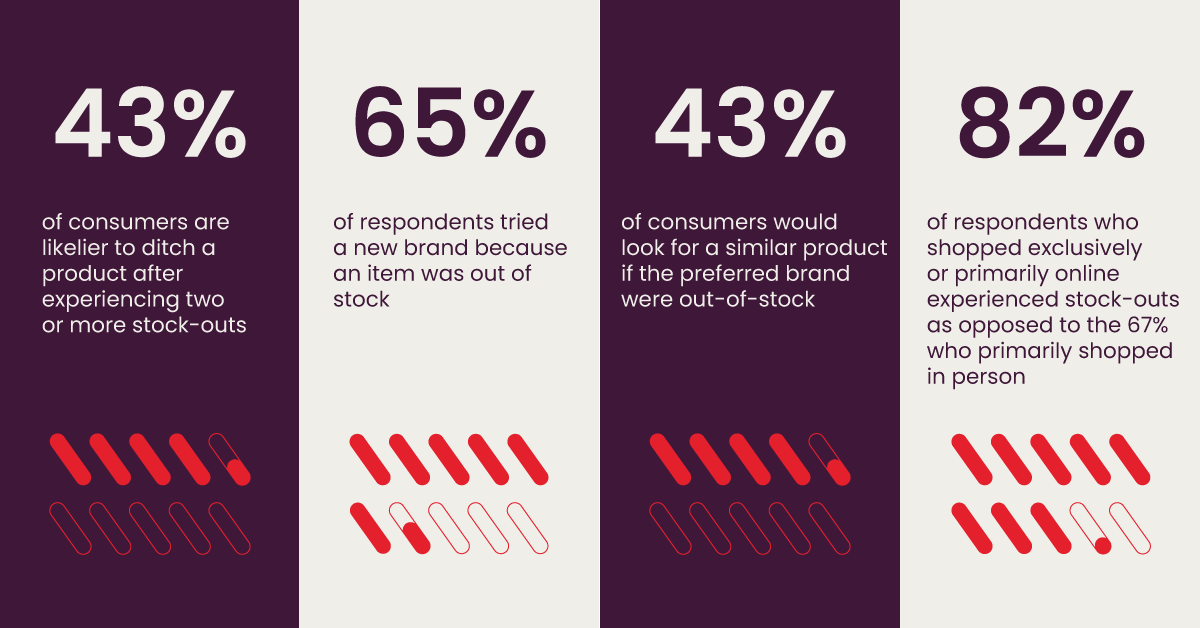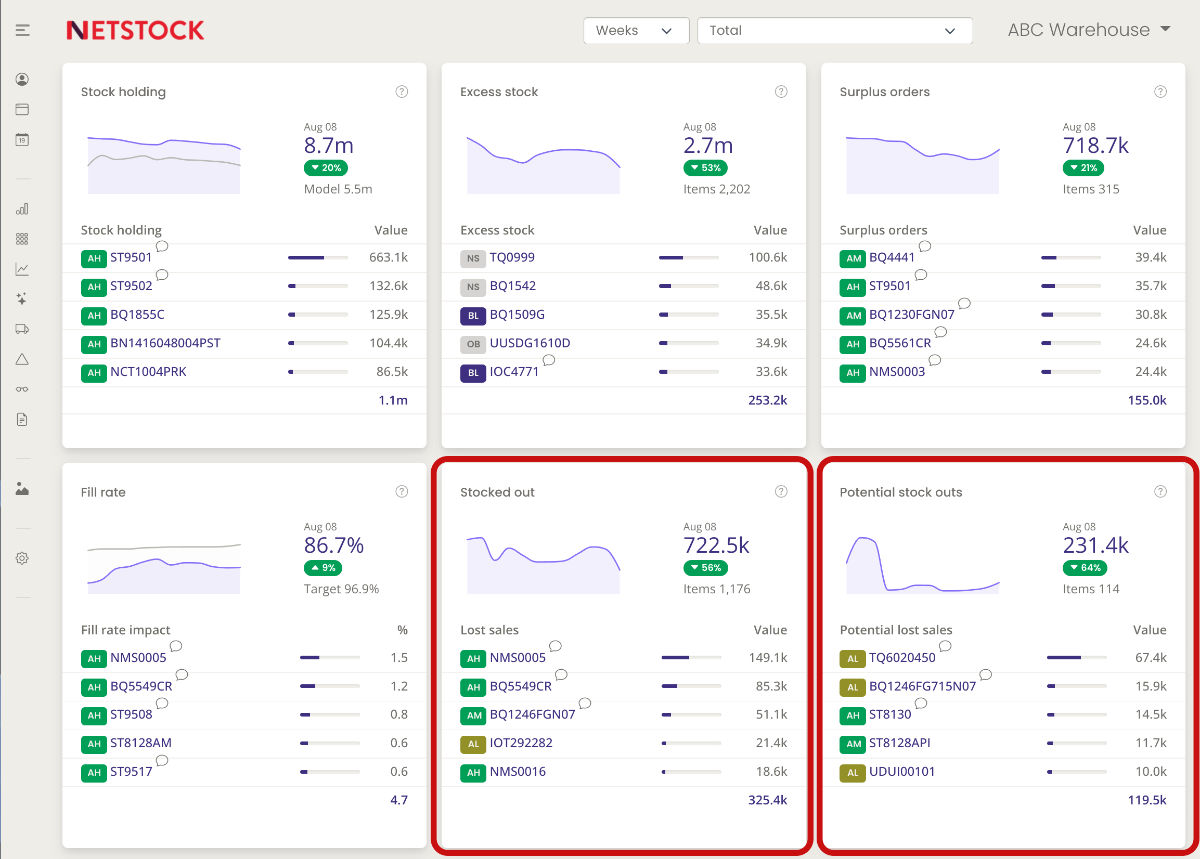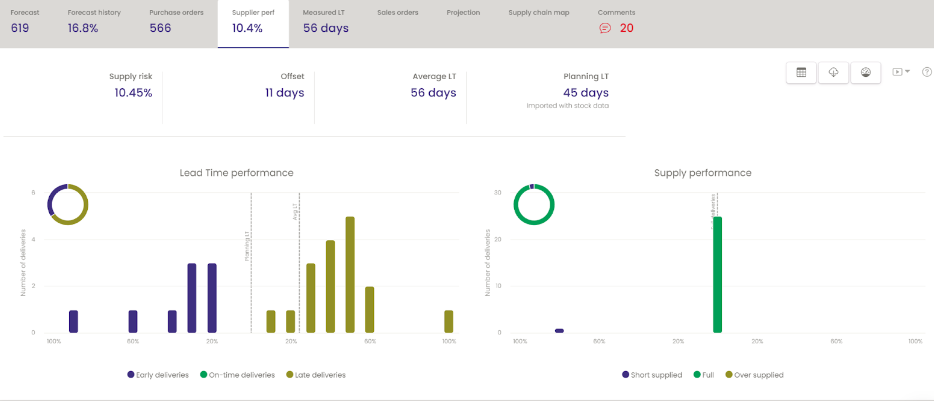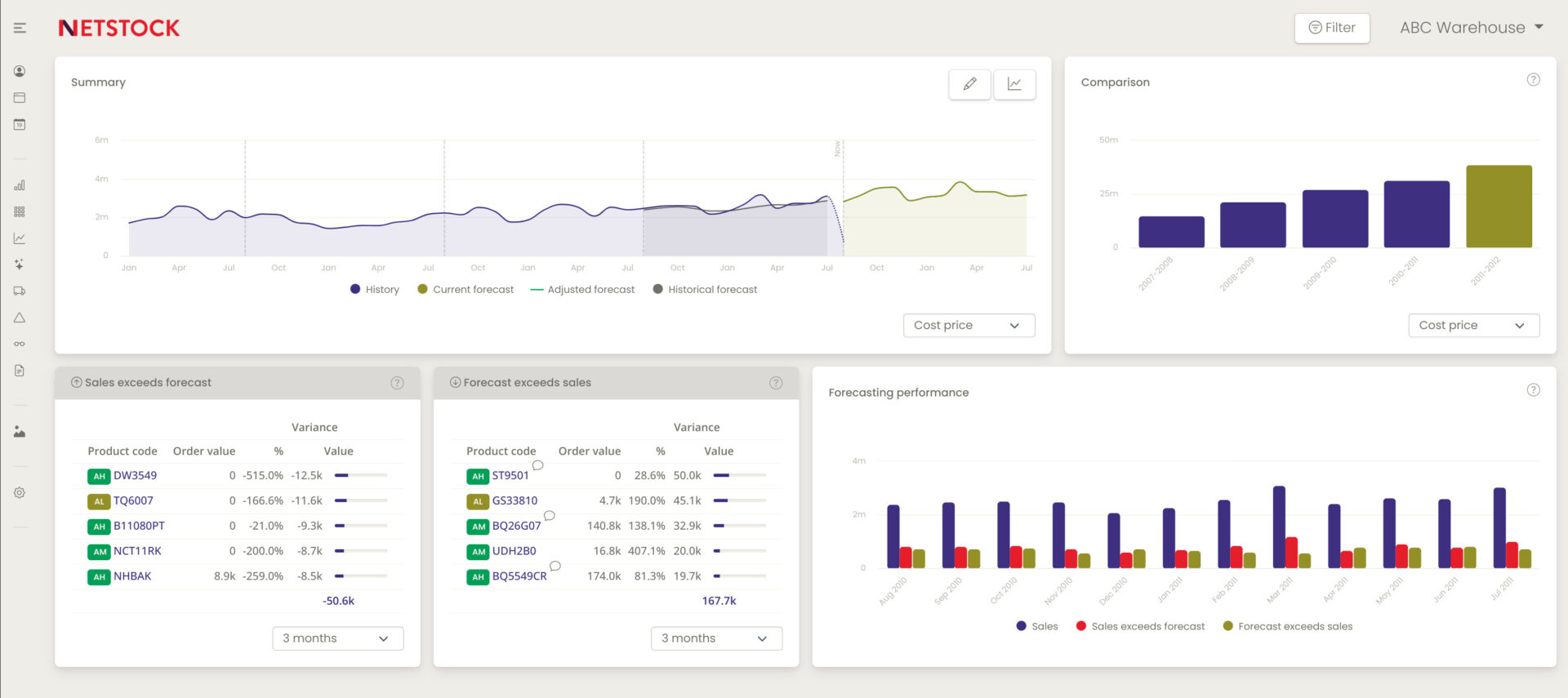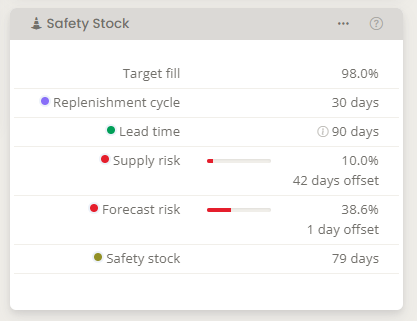Minimize inventory stock-outs by implementing efficient inventory management strategies. Work with accurate forecasts, improve safety stock levels, develop strong supplier relationships, and more!
How often has your business run out of stock in the last 12 months? Are you tired of putting out fires with your customers when you can’t deliver their orders on time and in full?
Inventory stock-outs can be a nightmare for businesses, often leading to lost sales, dissatisfied customers, and damaging reputations. Understanding the main causes behind why your business is experiencing stock-outs is crucial for effective inventory management. This post highlights the major pain points of inventory stock-outs, shedding light on factors contributing to this problem. By identifying and addressing these root causes, businesses can minimize stock-outs, optimize their overall inventory management strategies and drastically improve customer satisfaction.
Table of contents
1. What’s an inventory stock-out?
An inventory stock-out is when a business runs out of stock of a particular product or item. It occurs when the available quantity of a specific item falls below the demand or when there is no inventory left to meet customer orders or internal needs.
2. What causes stock-outs or potential stock-outs?
While addressing the cause of stock-outs is essential, figuring out the root cause of why you’re running out of items or experiencing stock-outs is even more crucial. Rather than merely treating the symptoms by rushing to purchase the stock you need, incurring additional costs for your business, you should focus on resolving the underlying issues.
Top ten factors causing stock-outs or potential stock-outs:
- Supply chain disruptions. Any supply chain disruption like natural disasters, labor strikes, shortages of materials, or production problems can impact the availability of goods, causing stock-outs.
- Poor demand forecasting. Inaccurate customer demand predictions can cause stock-outs and may require businesses to increase inventory to fulfill customer demand.
- Late delivery by a supplier. You ordered enough stock, but your supplier didn’t deliver when they were expected to or only delivered part of your order.
- Using the wrong lead time. A supplier lead time shorter than the time it takes for the supplier to deliver will result in the delivery arriving later than planned. The consequence of this is that the re-order level will be too low.
- Incorrect safety stock level. If your safety stock level is too low, you can’t cover the risk profile of an item.
- Under-ordering. This could result from a poor ordering system or poor decision-making. Many businesses decide how much to order at the point of ordering. A well-designed supply chain management system uses important information like forecast, lead time, planned replenishment cycle, and safety stock to determine the ideal order quantity.
- Seasonality and promotions. Unexpected spikes in demand due to seasonal fluctuations or sudden promotions can strain inventory levels and lead to stock-outs. Failing to anticipate and plan for these variations can result in stock-outs.
- Product quality issues. This can result in a high level of returns to the supplier.
- The supplier refuses to deliver. You may have a credit hold on your account from non-payment on your behalf.
- A shortage of working capital. This can limit the value of orders that can be placed each month. Poor cash flow management or other inventory issues, such as too much cash tied up in excess inventory could be a cause.
3. What’s the impact of products out of stock?
In a survey conducted by Netstock at the end of 2021, consumers shared their buying behaviors after experiencing a product being out of stock either online or shopping in person.
Here’s how stock-outs impact your business.
- Decreased customer satisfaction. When products are out of stock, customers cannot purchase what they need or want, leading to frustration and dissatisfaction.
- Lost sales and revenue. Out-of-stock products result in missed sales opportunities, causing a direct negative impact on revenue and potentially leading to financial losses for the business.
- Decreased customer loyalty. If customers consistently find products out of stock, they may lose trust in the business and seek alternatives, resulting in a decline in customer loyalty and potential long-term business relationships.
- Negative brand perception. Frequent out-of-stock situations can harm a company’s reputation and brand image, as customers may perceive it as unreliable or poorly managed.
- Increased operational costs. Managing stock-out situations requires additional efforts, such as inventory tracking, reordering, and restocking, increasing operational costs for the business.
- Disruptions in your supply chain. If products are frequently out of stock, it may indicate underlying issues in production delays, transportation problems, or inventory management inefficiencies.
- Missed cross-selling and upselling opportunities. When a product is out of stock, businesses overlook the chance to recommend or sell related or complementary products, reducing the potential for increased sales and customer value.
- Potential customer churn. Stock-outs may prompt customers to switch to competitors with readily available desired products, resulting in customer churn for the business.
- Damaged relationships with suppliers. Frequent stock-outs can strain relationships with suppliers, as they may face difficulties in meeting demand and may seek alternative partnerships.
4. Six key steps to avoid stock-outs
#1: Classify your stock
The first step to avoiding stock-outs is organizing and knowing the key SKUs contributing to your bottom line. Why? Those are the most-profitable items that shouldn’t be out of stock.You should know what your inventory is made up of, for example, which items you need to always have in stock and which are obsolete that you’ll never order again. Once you know that information, the next step is to classify your inventory according to its value: fast, medium, and slow in value items. Then take that classification one step further and add velocity, the speed at which the item sells; high, medium, or low.
Working with a tool that automatically classifies your inventory gives you the control to fully understand the stock items and the risks associated with those items that matter the most to your business.
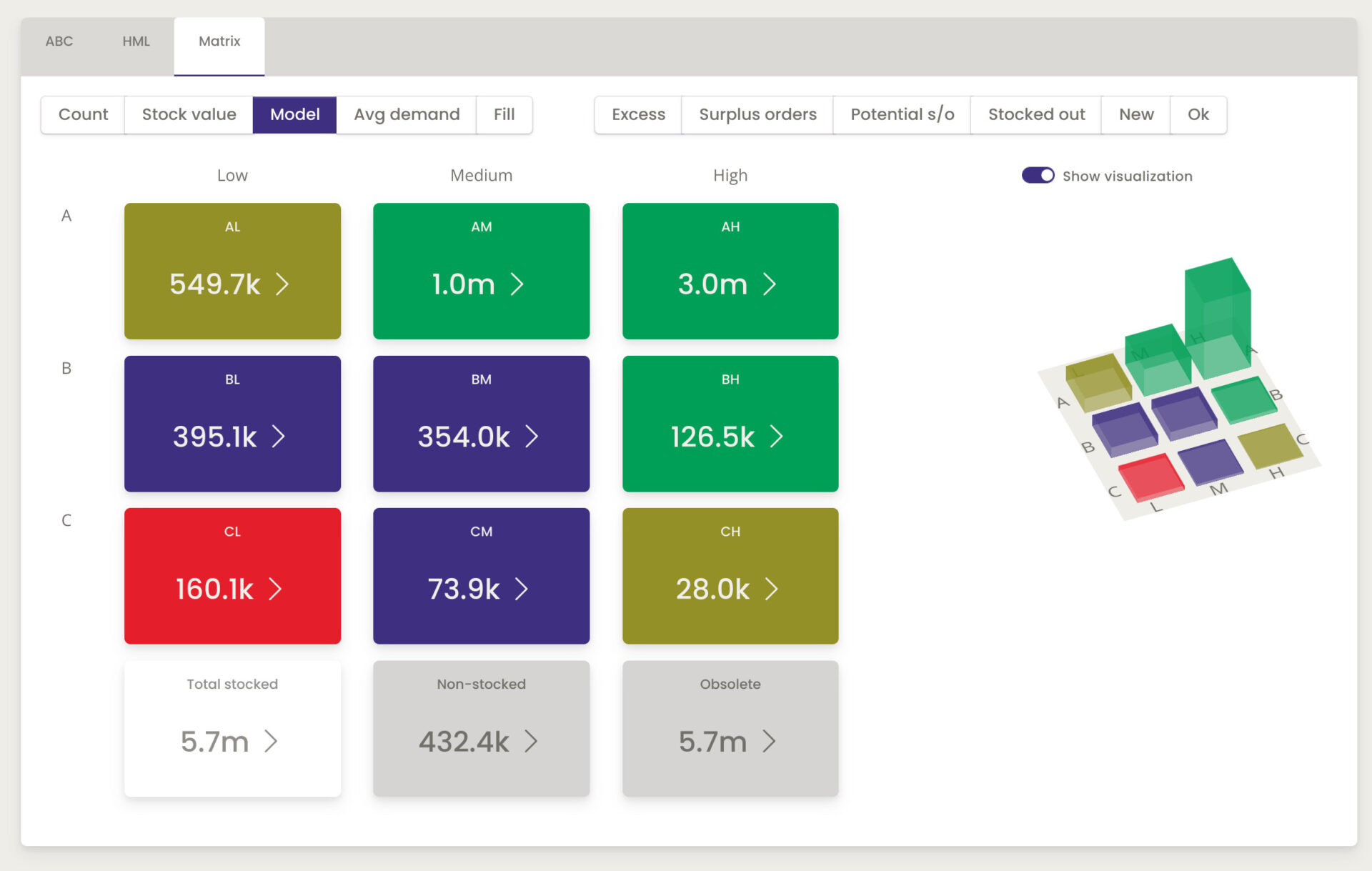
#2: Have visibility of inventory KPIs
Visibility of your inventory Key Performance Indicators (KPIs) provides real-time insights into stock holding, fill rates, and which items you’ll potentially experience stock-outs or where you’re in excess. By tracking these KPIs in one dashboard, planners can quickly focus time and resources on the top five critical SKUs that need attention. Increased visibility provides a proactive approach to preventing stock-outs, enhancing customer satisfaction, maximizing sales opportunities, and streamlining inventory management.
Working with an easy-to-view dashboard will provide the necessary visibility to monitor your potential stock-out closely.
Netstock’s dashboard shows you where you need to focus your efforts
#3: Measure your suppliers
Once you’ve classified your stock and know the items critical to your supply chain, you can quickly identify the suppliers for those items. Measuring how well your suppliers perform ensures you have better control over lead times to deliver on time and in full to your customers. Measuring your suppliers all starts with supplier data. You should be able to see how much you’ve purchased in the past, the status of delivery performance, current and future orders, and the value of the orders. Tracking supplier performance will identify where you may need to diversify your suppliers. With accurate supplier data, you can build out a secondary line of suppliers if your primary suppliers face challenges. Suppliers face their challenges, and building a good relationship with your key suppliers will give you the control to understand how delays will impact your inventory and what action you need to take to quickly avoid stock-outs. Working with a supply chain solution that provides supplier information is invaluable to success in today’s complex supply chain industry.
Netstock automatically monitors and improves lead times and adjust safety stock levels for you
#4. Increase forecasting accuracy
The more accurate your forecast, the less likely you’ll experience stock-outs. Erratic demand, introducing new products, once-off project sales, having an extensive product catalog, and market cannibalization are just some of the activities that make forecasting challenging. To create the best quality forecasts, you must establish a baseline forecast per item in your inventory and then adjust the forecast, considering seasonality, product growth, product replacement, and marketing campaigns. Improving forecasting accuracy starts with accurate data! Start by analyzing historical data to identify patterns and trends and collaborate with sales, marketing, and operations to incorporate upcoming sales or promotional campaigns that may impact demand. Utilize forecasting methods and incorporate market intelligence into your forecast. Engage in collaborative forecasting with suppliers, distributors, and customers and continuously monitor and adjust forecasts based on actual sales data.
Netstock delivers forecast accuracy with predictive intelligence
#5: Have the right amount of safety stock
Safety stock is an additional buffer of inventory you need to help with unexpected fluctuations in demand, supply disruptions, or delays in replenishment. Once you’ve classified your stock and know more about your suppliers, your safety stock acts as your ‘inventory insurance policy,’ preventing you from stocking out on key stock items. The purpose of safety stock is to protect you from the two significant inventory risks in your business; forecast risk: the inability to always forecast 100% accurately, and supply risk: suppliers’ failure to deliver on time and in full. To order the right amount of safety stock, you need to calculate each item’s risk profile and set the safety stock level according to that profile. Typically calculating how much safety stock you need to allocate to each SKU depends on the target fill rate you want to achieve, forecast accuracy, length and reliability of the lead time, and the replenishment cycle. Remember to also keep safety stock levels dynamic by regularly reviewing and adjusting safety stock levels based on changing supply and demand risks, changes to the forecasts, and business objectives.
Netstock automatically adjusts your safety stock levels in line with each SKU’s risk profile.
Learn more about how to manage Safety Stock here.
#6: Utilize supply chain software to automate processes
Investing in predictive supply chain planning software can improve visibility, automate processes, and save time by eliminating manual inventory planning processes. There are many steps to consider when managing inventory, and working with the right software helps predict and plan the right stock you need at the right time. Supply chain software provides real-time inventory data, improves forecasting and demand planning, and automatically triggers reorder points, ensuring optimal stock levels. You’ll save valuable time with automated purchase orders, work orders, and distribution plans to restock inventory accurately across your warehouse network. Software helps to integrate and leverage data from various sources to streamline procurement, production, and distribution processes, minimizing lead times and reducing the likelihood of stock-outs, ensuring products are available when and where needed, ultimately improving customer satisfaction and maximizing sales opportunities.
Netstock’s AI Opportunity Engine alerts you to potential stock-outs and offers real-time recommendations.
5. How to compensate customers in the event of stock-outs
If your supply chain experiences a stock-out situation, you should have a plan to compensate your customers. It’s essential to assess the situation, consider the options available, and tailor your approach to best suit your business and customer needs.
Here are eight steps to consider for your compensation plan.
- Keep communicating. Notify your customers as soon as possible about the stock-out situation, providing clear and transparent information about the issue, including the reasons behind it and an estimated timeline for resolution.
- Offer alternatives. Present customers with alternative products or models currently available that can somewhat meet their needs. Provide detailed information about the alternatives, highlighting their features and benefits.
- Provide partial fulfillment. If you have a partial inventory available, consider fulfilling a portion of the customer’s order to minimize the inconvenience caused by the stock-out. Offer options to ship the available items immediately or wait until the entire order can be fulfilled.
- Prioritize backorders. If customers are willing to wait for the restocking of the out-of-stock items, offer the option to place a backorder. Assure them that the items will be shipped as soon as they become available and keep them informed about the progress.
- Offer expedited shipping or discounts. If feasible, provide expedited shipping options at no additional cost to customers affected by the stock-out. Alternatively, offer discounts on future purchases or coupons as a gesture of goodwill and compensation for the inconvenience caused.
- Provide regular updates. Maintain open lines of communication with your customers, keeping them informed about the progress of restocking efforts and any changes in the estimated timeline. This helps manage their expectations and demonstrates your commitment to resolving the issue.
- Offer refunds or cancellation options. If the stock-out situation is prolonged or the customer is no longer willing to wait, provide the option for a full refund or order cancellation without any penalties. Make the refund process smooth and hassle-free to retain customer satisfaction.
- Consider alternative suppliers or sourcing methods. Explore the possibility of sourcing the out-of-stock items from alternative suppliers or adopting alternative production methods if viable. This can help expedite the restocking process and minimize the impact on customer orders.
6. Retailers, Manufacturers, and Distributors who’ve prevented stock-outs
Case study B&G Ltd reduced stock-outs by 61%
B&G Ltd is a leading importer and distributor of Quality Home Improvement & DIY Products and distributes through builders, merchants, and DIY stores. Since using Netstock, they have abandoned working on spreadsheets completely.
Since implementing Netstock less than 18 months ago, we have not only saved a lot of time preparing forecasts, we have reduced stock-outs by 61% and improved our customer fill rate from 80 – 93.6% – B&G Ltd
Case study Best Vinyl reduces inventory value by 50%
Best Vinyl is a leading vinyl fence company supplying and installing scientifically advanced vinyl products. Using Netstock, they’ve reduced inventory from $2.7 million to $1.4 million in under two years while maintaining high customer service levels.
With the Netstock dashboard, I can quickly see stock-outs and potential stock-outs, which allows me to have a focussed conversation with my sales team to determine what’s coming up and what else I need to consider when placing orders – Best Vinyl
Case study Tayse Rugs reduces lost sales from stock-outs
Tayse Rugs imports a large selection of rugs from Turkey and supplies eCommerce businesses like Amazon, Walmart, Home Depot, and large retail chain stores throughout the USA. Since using Netstock, they no longer lose sales due to stock-outs.
For me, the Netstock classification matrix is an impressive feature as it looks at high-value and high-velocity items and plots them on a matrix that defines each item’s level of importance in your business. We could quickly see which were our slow-moving items and, by running promotions, could reduce those. We now have that “big picture” view and can action things like potential stock-outs before it becomes a problem – Tayse Rugs

